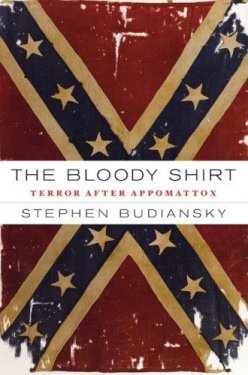 One of the very few perks of writing this blog is that every once in a while a publisher sees fit to send me a copy of a book for review. This most recent, The Bloody Shirt: Terror after Appomattox by Stephen Budiansky (Viking Press, $27.95) was a really good read, and I highly recommend it – with a caveat. If you are enamored of the “character” of individuals like Wade Hampton or Matthew Butler, or if you despise traditional Reconstruction “villains” or at best “failures” like Bull Run Medal of Honor recipient Adelbert Ames, be prepared to have your preconceptions challenged.
One of the very few perks of writing this blog is that every once in a while a publisher sees fit to send me a copy of a book for review. This most recent, The Bloody Shirt: Terror after Appomattox by Stephen Budiansky (Viking Press, $27.95) was a really good read, and I highly recommend it – with a caveat. If you are enamored of the “character” of individuals like Wade Hampton or Matthew Butler, or if you despise traditional Reconstruction “villains” or at best “failures” like Bull Run Medal of Honor recipient Adelbert Ames, be prepared to have your preconceptions challenged.
Rage – that’s what this book elicits; if that’s too strong, it’s at least similar to that queasy, pit-of-the-stomach feeling you get while watching a movie in which the hero is “set up” for a crime he didn’t commit, and has to fight a system stacked against him. Budiansky argues that the Reconstruction Yankees and African-Americans, at least those he profiles, were good men with a good cause. Men like Ames, 7th Cavalry Major Lewis Merrill, former slave and soldier Prince Rivers, and Albert T. Morgan fought the good fight, but the odds were decidedly not in their favor. In addition, they seem to have received little support from the federal government. (I really wish Budiansky had explored this aspect further; while Andrew Johnson traditionally takes the heat for the failure of Reconstruction, Ulysses S. Grant was president during most of the period covered in this book, yet is a non-entity in it. Perhaps the author felt no comment was comment enough. I’d really like to hear what someone with knowledge of Grant and Reconstruction has to say about this – maybe someone like Brooks Simpson?)
Few and far between were prominent southerners, like James Longstreet, who had any interest in reconciling with the rest of the country under the terms suggested by the ruling party – namely, the establishment of black suffrage. Influential white southerners were most interested in returning to the status quo that existed prior to the war, despite the fact that the war was fought to maintain that status quo, and the South lost that test of arms. Part of this effort was the formation of the Ku Klux Clan, White Leagues, and various gun clubs. Ultimately, they were successful. Through intimidation, violence, and fraud Democrats began to win back the southern states. The north was described by the Federal government as “tired” of the violence, and Reconstruction was abandoned after 1876. With that, many claim, the Confederacy essentially won the Civil War.
I was struck by the extensive passages from southern newspapers, which boldly and blatantly declared their positions. They did not mince words – they knew what the Ku Kluxers and White Leaguers were about, and they wholeheartedly, even glibly supported them and their tactics.
The book climaxes with the murders that took place at predominantly African-American Hamburg, SC under the direction of “Pitchfork” Ben Tillman and Matthew C.Butler, and serves to depict in microcosm the Passion Play that was the life and death of Reconstruction. This incident mirrors that which occurred in Colfax, LA, covered in Nicholas Lemann’s 2006 offering Redemption: The Last Battle of the Civil War. (I haven’t read it yet, but plan to do so in the near future.)
The successful attempt of Southerners to shape public perception of Reconstruction, similar and integral to the creation of the Lost Cause myth, is also briefly covered. The pretzel logic of this PR campaign, which laid the blame for the violence of Reconstruction at the feet of the Reconstructionists and African Americans, is described by Budiansky in his introduction. He explores and exposes the myth of the Bloody Shirt (waving the bloody shirt was and still is a tactic used by politicians in which the blood of heroes or martyrs is used to gain support or deflect criticism). He argues:
The bloody shirt perfectly captured the inversion of truth that would characterize the distorted memories of Reconstruction the nation would hold for generations after. The way it made a victim of the bully and a bully of the victim, turned the very act of Southern white violence into wounded Southern innocence, turned the very blood of their African American victims into an affront against Southern white decency; the way it suggested that the real story was not the atrocities white Southerners committed but only the attempt by their political enemies to make political hay out of those atrocities. The merest hint that a partisan motive lay behind the telling of these tales was enough to satisfy most white Southerners that the events never happened, or were exaggerated, or even that they had been conspiratorially engineered by the victims themselves to gain sympathy or political advantage.
If it was incomprehensible to many Northerners, it made perfect sense to those same white Southerners who, on more than one occasion, blamed the “cowardly negroes” for their unmanliness in having permitted themselves to be massacred by bands of armed white men: it only showed, they argued in complete earnest, that black men lacked the Anglo-Saxon virtues indispensable to free men who would exercise the lofty privilege of self-government. Any people who allowed their vote to be taken from them at gunpoint didn’t deserve to keep it.
To quote Yossarian: That’s some catch, that Catch-22.


Harry,
“Redemption” is terrific. It focuses primarily on Ames and his battles with the status quo as he attempts to have some sort of political life in the South.
Take care,
Aly
LikeLike
Thanks Harry,
I’m about halfway through the volume myself. I can only read a chapter or so at a time before boiling over. It has already changed my perspective considerably.
LikeLike
Alyce,
I finished Gerry Prokopwicz’z book on Lincoln today, and will start Lemann’s tonight.
Brian,
It’s comforting to learn I’m not the only who felt that way while reading this book!
LikeLike
Quite frankly, none of this should be new to anybody that has been keeping up with scholarship over the last 10-20 years, or more.
LikeLike
David,
It’s not so much the content as the presentation in this case, though I will admit that Reconstruciton has not been my bag over the years.
LikeLike
[…] The Last Battle of the Civil War, by Nicholas Lemann, was described briefly here in my post on Stephen Budiansky’s The Bloody Shirt (follow the hyperlinks, folks: they’re there […]
LikeLike
Reconstruction was the Marshall plan in reverse, a military occupation which concentrated on keeping all the experienced, competent public officials out of public affairs, to tax and restrict economic activity, and to maintain a monologue of hatred against the former rebels. Reconstruction was successful in driving the entire South deeper into poverty and chaos than it had been at the end of the war.
Historians like Budiansky have carefully edited out all that. He perpetuates the propaganda that began in the 1830’s as Abolitionism, and has continued today as socially acceptable “You Might Be A Redneck If…”
As in any propaganda campaign, there are germs of truth in the stereotypes.
The blacks who were shot in Hamburg, for instance, were true victims, their shooters committed a crime. But the events that led to the confrontation, the dangerous ghetto that Hamburg had become, the harassment and peril to whites trying to drive through the weed-choked streets of Hamburg to get to the Augusta Bridge, were genuine problems that Budiansky has edited out. These “inconvenient truths” detract from the political objective he is pushing.
LikeLike